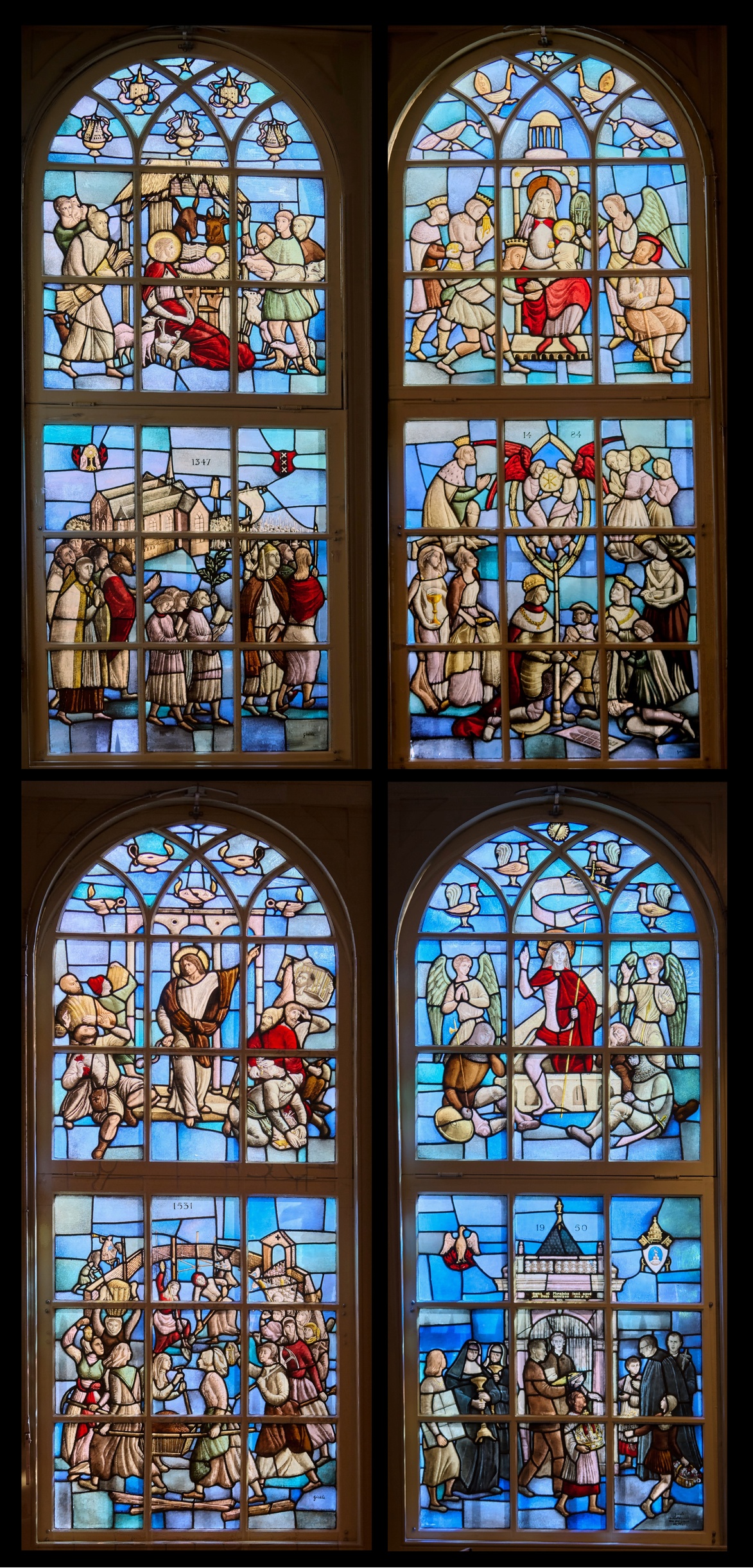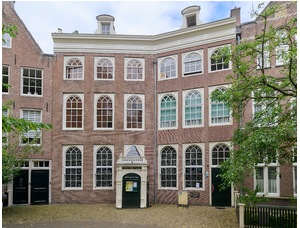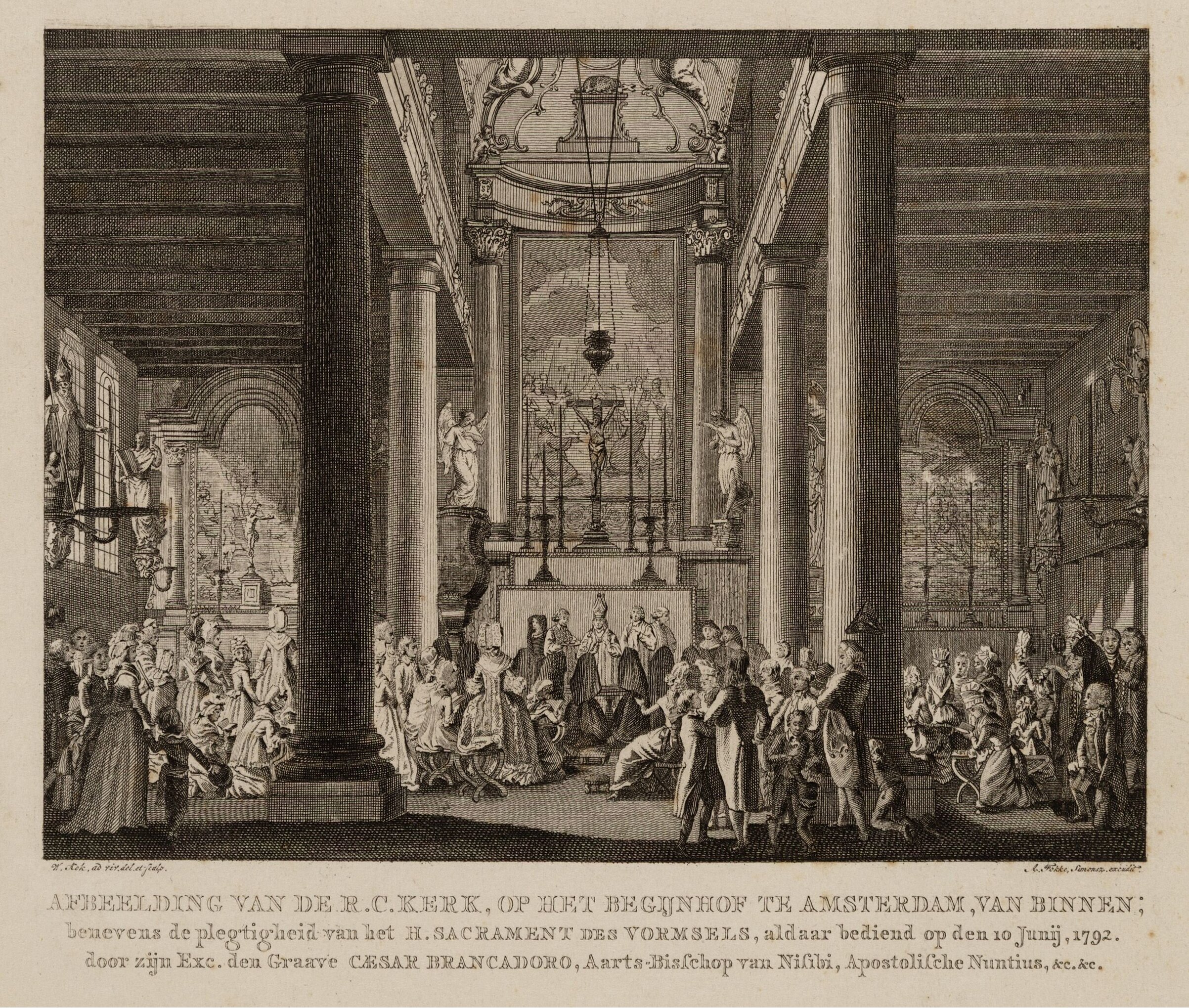The history of the Chapel of the Beguinage is depicted in four sparkling stained-glass windows.
Location
Chapel of St John and St Ursula (Chapel of the Beguinage)
Begijnhof 29
Type
Hidden church
Religious community
Roman Catholic Church
Object
Four stained-glass windows depicting the history of the devotion to the Miracle of Amsterdam
Maker and date
Gisèle van Watersloot van der Gracht
1951
Visit
The windows are on display in the Chapel of the Beguinage
The Miracle of Amsterdam Through the Centuries
When Amsterdam architect Philips Vingboons (1607-1668) built the Chapel of the Beguinage in 1665 on the initiative of Pastor Van der Mye (1665-1700), he also designed the windows for the chapel. Probably neutral glass was placed in them. An etching by Fokke Simonsz. from 1792 shows that they must have been rather high windows and that they let light through. When the side chapel was designed by architect A. Bleys (1842-1912) in 1885, several sketches were made for the windows, but they were never executed.
Pastor
(Latin for shepherd) is the priest, to whom the leadership of a parish (church) is entrusted by the bishop.
The first serious commission for stained-glass windows in the Beguinage was granted to artist Gisèle van Watersloot van der Gracht. Gisèle van Watersloot van der Gracht came from a prominent family and was given the opportunity to study at the Académie Julian in Paris. There she learnt to etch. In 1935, she became the apprentice of the innovative Roermond artist and glazier Joep Nicolas (1897-1972). There she learnt to work expressively.
In 1949 she was commissioned by the Society of the Stille Omgang to design four windows depicting the history of the Miracle of Amsterdam for the Chapel of the Beguinage. The choice of this subject is not strange. Soon after the Protestant takeover of the Heilige Stede, the Beguinage became the new centre of the devotion to the Miracle of Amsterdam. The veneration of the Miracle is maintained there to this day.
The completion of the first two windows in 1951 coincided with the re-commissioning of the chapel after a thorough renovation. The upper windows depict a Miracle Procession in 1347, and Emperor Maximilian, Philip the Handsome and Mary of Burgundy kneeling before the Sacrament of the Miracle. The lower two windows tell of women of the Guild of the Blessed Sacrament forming a human shield against iconoclasm and the re-commissioning of the Chapel of the Beguinage in 1950. On this last window, the artist also depicted herself carrying a stained glass window. Thereby, the four windows captured the entire history of this special place.
Heilige Stede
Literally ''holy place''. It refers to the location on Kalverstraat where the Miracle of Amsterdam took place in 1345. After the Protestant takeover in 1578, this church was also called Nieuwezijds Kapel. The original church that stood at this location was demolished in 1908 and was replaced by a new church building also called the Nieuwezijds Kapel.
Miracle of Amsterdam
The Miracle of Amsterdam took place in 1345 in a house on Kalverstraat. After a dying man could not keep down his last Holy Communion, a maid threw the vomit with the Blessed Host into the fireplace. The Host was found intact in the fireplace the next day. They concluded that God was present here in a special way and that He wanted to be worshipped in the Blessed Host at this location. Shortly afterwards, they built a pilgrimage chapel at the same location, which was called the Heilige Stede (Holy Place). This chapel was demolished in 1908.
Stille Omgang
The Stille Omgang (Dutch: Silent Procession) is an annual procession in Amsterdam in honour and remembrance of the Miracle of Amsterdam. It takes place on the first Saturday after the 15th of March. The Stille Omgang is a continuation of the traditional medieval walk along important locations related to the Miracle of Amsterdam. Catholic processions were prohibited until 1983. Therefore, the Stille Omgang is held in silence and without any visible Catholic symbols or displays. This tradition is maintained to this day.
Ingrid Henkemans
Heritage Specialist Museum Catharijneconvent
Last edited
October 24, 2024
Four stained-glass windows, design Gisèle van Watersloot van der Gracht, Atelier Bogtman, Haarlem, 1951. Collection Rectoraatskerk HH. Joannes en Ursula. Photography Robert Westera.
Interior and exterior: photography Robert Westera.
Bediening van het H. Sacrament des Vormsels, in de R.C. Kerk, op 't Begijnhof te Amsterdam; den 10 Junij, 1792, Fokke Simonsz., c. 1792. Collection City Archives Amsterdam
Miracle procession (lower part of window 1), Gisèle van de Watersloot van der Gracht, 1951. Collection Rectoraatskerk HH. Joannes en Ursula. Photography Robert Westera.
Dijk, G. van, Van ‘Der Beghinenlande’ tot Begijnhof. De geschiedenis van het Begijnhof van 1307 tot heden (2004) p. 75-77.
Hoogveld, C., eindred. Bergvelt, E. en Burkom, F. van, Glas in lood in Nederland. 1817-1968 ('s-Gravenhage 1989) 353.
L, G. v., Begijnhofkerkje in herwonnen luister, (2 januari 1950).
Mooij, A., De eeuw van Gisèle. Mythe en werkelijkheid van een kunstenares (De Bezige Bij 2024) 70.
'Nieuwe ramen op het Begijnhof' in: De Tijd (27 januari 1951).









